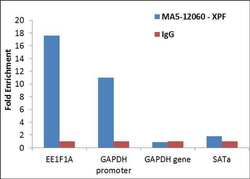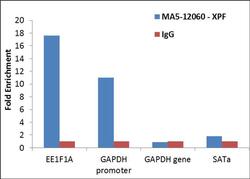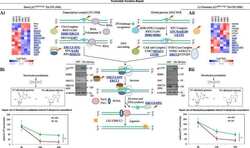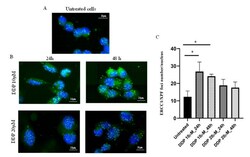Antibody data
- Antibody Data
- Antigen structure
- References [10]
- Comments [0]
- Validations
- Chromatin Immunoprecipitation [2]
- Other assay [2]
Submit
Validation data
Reference
Comment
Report error
- Product number
- MA5-12060 - Provider product page

- Provider
- Invitrogen Antibodies
- Product name
- XPF Monoclonal Antibody (51)
- Antibody type
- Monoclonal
- Antigen
- Recombinant full-length protein
- Description
- MA5-12060 targets XPF in WB applications and shows reactivity with Human samples. The MA5-12060 immunogen is recombinant human XPF protein.
- Reactivity
- Human
- Host
- Mouse
- Isotype
- IgG
- Antibody clone number
- 51
- Vial size
- 500 μL
- Concentration
- 0.2 mg/mL
- Storage
- 4°C
Submitted references Impact of ERCC1, XPF and DNA Polymerase β Expression on Platinum Response in Patient-Derived Ovarian Cancer Xenografts.
Mutational signatures reveal the role of RAD52 in p53-independent p21-driven genomic instability.
Persistent 3'-phosphate termini and increased cytotoxicity of radiomimetic DNA double-strand breaks in cells lacking polynucleotide kinase/phosphatase despite presence of an alternative 3'-phosphatase.
A small molecule screen identifies an inhibitor of DNA repair inducing the degradation of TFIIH and the chemosensitization of tumor cells to platinum.
Xeroderma pigmentosum group F protein binds to Eg5 and is required for proper mitosis: implications for XP-F and XFE.
Delayed c-Fos activation in human cells triggers XPF induction and an adaptive response to UVC-induced DNA damage and cytotoxicity.
Repair of laser-localized DNA interstrand cross-links in G1 phase mammalian cells.
Sequential recruitment of the repair factors during NER: the role of XPG in initiating the resynthesis step.
gamma-H2AX formation in response to interstrand crosslinks requires XPF in human cells.
Phosphorylation of XPB helicase regulates TFIIH nucleotide excision repair activity.
Guffanti F, Alvisi MF, Caiola E, Ricci F, De Maglie M, Soldati S, Ganzinelli M, Decio A, Giavazzi R, Rulli E, Damia G
Cancers 2020 Aug 24;12(9)
Cancers 2020 Aug 24;12(9)
Mutational signatures reveal the role of RAD52 in p53-independent p21-driven genomic instability.
Galanos P, Pappas G, Polyzos A, Kotsinas A, Svolaki I, Giakoumakis NN, Glytsou C, Pateras IS, Swain U, Souliotis VL, Georgakilas AG, Geacintov N, Scorrano L, Lukas C, Lukas J, Livneh Z, Lygerou Z, Chowdhury D, Sørensen CS, Bartek J, Gorgoulis VG
Genome biology 2018 Mar 16;19(1):37
Genome biology 2018 Mar 16;19(1):37
Persistent 3'-phosphate termini and increased cytotoxicity of radiomimetic DNA double-strand breaks in cells lacking polynucleotide kinase/phosphatase despite presence of an alternative 3'-phosphatase.
Chalasani SL, Kawale AS, Akopiants K, Yu Y, Fanta M, Weinfeld M, Povirk LF
DNA repair 2018 Aug;68:12-24
DNA repair 2018 Aug;68:12-24
A small molecule screen identifies an inhibitor of DNA repair inducing the degradation of TFIIH and the chemosensitization of tumor cells to platinum.
Alekseev S, Ayadi M, Brino L, Egly JM, Larsen AK, Coin F
Chemistry & biology 2014 Mar 20;21(3):398-407
Chemistry & biology 2014 Mar 20;21(3):398-407
Xeroderma pigmentosum group F protein binds to Eg5 and is required for proper mitosis: implications for XP-F and XFE.
Tan LJ, Saijo M, Kuraoka I, Narita T, Takahata C, Iwai S, Tanaka K
Genes to cells : devoted to molecular & cellular mechanisms 2012 Mar;17(3):173-85
Genes to cells : devoted to molecular & cellular mechanisms 2012 Mar;17(3):173-85
Delayed c-Fos activation in human cells triggers XPF induction and an adaptive response to UVC-induced DNA damage and cytotoxicity.
Tomicic MT, Reischmann P, Rasenberger B, Meise R, Kaina B, Christmann M
Cellular and molecular life sciences : CMLS 2011 May;68(10):1785-98
Cellular and molecular life sciences : CMLS 2011 May;68(10):1785-98
Repair of laser-localized DNA interstrand cross-links in G1 phase mammalian cells.
Muniandy PA, Thapa D, Thazhathveetil AK, Liu ST, Seidman MM
The Journal of biological chemistry 2009 Oct 9;284(41):27908-27917
The Journal of biological chemistry 2009 Oct 9;284(41):27908-27917
Sequential recruitment of the repair factors during NER: the role of XPG in initiating the resynthesis step.
Mocquet V, Lainé JP, Riedl T, Yajin Z, Lee MY, Egly JM
The EMBO journal 2008 Jan 9;27(1):155-67
The EMBO journal 2008 Jan 9;27(1):155-67
gamma-H2AX formation in response to interstrand crosslinks requires XPF in human cells.
Mogi S, Oh DH
DNA repair 2006 Jun 10;5(6):731-40
DNA repair 2006 Jun 10;5(6):731-40
Phosphorylation of XPB helicase regulates TFIIH nucleotide excision repair activity.
Coin F, Auriol J, Tapias A, Clivio P, Vermeulen W, Egly JM
The EMBO journal 2004 Dec 8;23(24):4835-46
The EMBO journal 2004 Dec 8;23(24):4835-46
No comments: Submit comment
Supportive validation
- Submitted by
- Invitrogen Antibodies (provider)
- Main image

- Experimental details
- Enrichment of endogenous XPF protein at specific gene loci using Anti-XPF Antibody: Chromatin Immunoprecipitation (ChIP) was performed using Anti-XPF Mouse Monoclonal Antibody (Product # MA5-12060, 3 µg) on sheared chromatin from 2 million HeLa cells treated with UV (2 hours) using the MAGnify ChIP system kit (Product # 49-2024). Normal Rabbit IgG was used as a negative IP control. The purified DNA was analyzed by qPCR with PCR primer pairs over EE1F1A, GAPDH promoter (active) and GAPDH gene, SAT alpha (inactive). Data is presented as fold enrichment of the antibody signal versus the negative control IgG using the comparative CT method.
- Submitted by
- Invitrogen Antibodies (provider)
- Main image

- Experimental details
- Enrichment of endogenous XPF protein at specific gene loci using Anti-XPF Antibody: Chromatin Immunoprecipitation (ChIP) was performed using Anti-XPF Mouse Monoclonal Antibody (Product # MA5-12060, 3 µg) on sheared chromatin from 2 million HeLa cells treated with UV (2 hours) using the MAGnify ChIP system kit (Product # 49-2024). Normal Rabbit IgG was used as a negative IP control. The purified DNA was analyzed by qPCR with PCR primer pairs over EE1F1A, GAPDH promoter (active) and GAPDH gene, SAT alpha (inactive). Data is presented as fold enrichment of the antibody signal versus the negative control IgG using the comparative CT method.
Supportive validation
- Submitted by
- Invitrogen Antibodies (provider)
- Main image

- Experimental details
- NULL
- Submitted by
- Invitrogen Antibodies (provider)
- Main image

- Experimental details
- Figure 2 Detection and quantification of ERCC1/XPF foci numbers per nucleus (PLA) in A2780 ovarian cancer cells, untreated and after DDP. Nuclei of A2780 cells are shown in blue (DAPI) and ERCC1/XPF foci in the nuclei as green dots (FITC); magnification 40x, fluorescent microscopy. ( A ): ERCC1/XPF complexes expressed in untreated cells; ( B ): ERCC1/XPF foci in A2780 cells 24 h and 48 h after 10 muM (IC 50 ) and 20 uM DDP-treatment; ( C ): quantification of ERCC1/XPF foci number per nucleus in A2780 untreated and DDP-treated cells with 10 uM (IC 50 ) and 20 uM, fixed at two different time points. Each value is the mean +- standard deviation of three replicates and at least 50 nuclei were analyzed for each sample in different fields. Unpaired t -test was used to compare untreated vs. treated cells; * p
 Explore
Explore Validate
Validate Learn
Learn Western blot
Western blot Chromatin Immunoprecipitation
Chromatin Immunoprecipitation